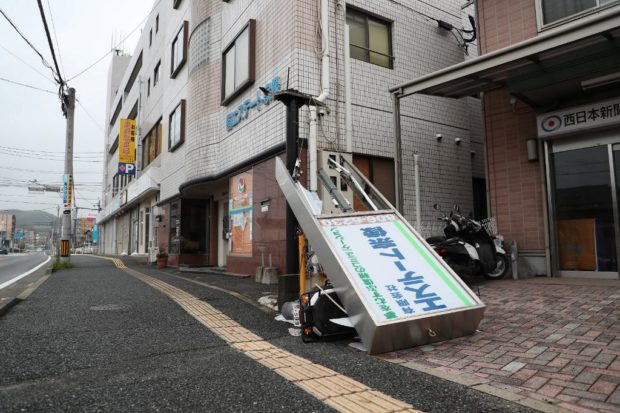One dead after Typhoon Nanmadol slams into Japan

A signboard believed to have been damaged due to strong winds rests over a toppled scooter in Fukuoka on Kyushu island on September 19, 2022, as Typhoon Nanmadol made landfall in southwestern Japan the day before. (Photo by JIJI Press / AFP)
Izumi, Japan — One person was confirmed dead in Japan on Monday after Typhoon Nanmadol slammed into the country, injuring dozens, but authorities downgraded warnings as the storm weakened after landfall.
The storm system, which made landfall in southern Kyushu’s Kagoshima on Sunday night, was moving off the western coast of Japan by Monday afternoon.
Nearly six million people were still under evacuation warnings and authorities said in some areas “even a tiny amount of additional rainfall” could trigger flooding and landslides.
In Miyazaki prefecture, some areas saw more rainfall in 24 hours than they normally receive in all of September.
A man in his sixties from Miyakonojo city was confirmed dead after being found in a submerged car on farmland, authorities in Miyazaki told AFP.
Article continues after this advertisementIn western Fukuoka region, officials said they were investigating whether an additional death was linked to the storm.
Article continues after this advertisementPrime Minister Fumio Kishida, who had been scheduled to leave Monday for the United Nations General Assembly, announced he would delay his trip by a day to assess the damage.
But given the intensity of the storm, which came ashore packing gusts of up to 234 kilometers (145 miles) per hour, damage appeared relatively limited.
“The typhoon has all but disappeared today and the rain and wind are also subsiding now,” an official in charge of crisis management in Miyazaki’s Saito city told AFP.
‘I didn’t feel safe at home’
In the town of Izumi in Kagoshima prefecture, 30-year-old Yasuta Yamaguchi spent the night in a local hotel to shelter from the storm.
“I came to the hotel to shelter myself because it was windy and I thought it was dangerous,” he told AFP.
“I didn’t feel safe at home.”
By Monday afternoon, over 240,000 households in Kyushu and neighboring Chugoku region were without power, utilities said. Hundreds of flights had been cancelled, and many train services throughout the affected regions were also halted.
By 4:00 pm (0700GMT), the typhoon was moving north-northeast off the coast of Shimane prefecture on the western side of Japan, with maximum gusts of around 162 kilometers per hour, according to the JMA.
“The thick cloud and eye area around the typhoon’s center have already disappeared and it is weakening rapidly,” Ryuta Kurora, the head of the JMA’s forecast unit, told reporters.
Japan is currently in its typhoon season and faces around 20 such storms a year, routinely seeing heavy rains that cause landslides or flash floods.
In 2019, Typhoon Hagibis smashed into Japan as it hosted the Rugby World Cup, claiming the lives of more than 100 people.
A year earlier, Typhoon Jebi shut down Kansai Airport in Osaka and left 14 people dead in its wake.
Scientists say climate change is increasing the severity of storms and causing extreme weather such as heat waves, droughts and flash floods to become more frequent and intense.